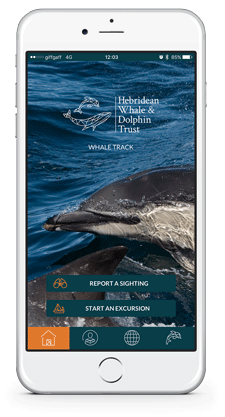
Working on a number of research projects, we are always on the lookout for ways to better understand and protect marine life.
Projects include:
- Acoustic Harbour Porpoise Monitoring
- Building Evidence for Marine Protected Areas
- Preventing Large Whale Entanglement
- Monitoring Scotland’s Killer Whales
- Monitoring Migratory Minke Whales
- Tracking Hebridean Bottlenose Dolphins
- Whale Track App
ACOUSTIC HARBOUR PORPOISE MONITORING
Passive Acoustic Monitoring plays a key role in HWDT research, as an accurate way of recording the presence of harbour porpoise. HWDT is a pioneer in the field of underwater acoustic monitoring – Silurian recorded it's first cetacean sounds on a towed hydrophone back in 2002. Since then, HWDT has complied a comprehensive acoustic dataset, spanning 15 years, comprising of over 6,000 hours (250 continuous days) of underwater recordings. These recordings are increasingly called upon to assess the changing soundscape of the west coast marine environment.
Building Evidence for marine protected areas
HWDT established much of the evidence base for Scotland’s first proposed marine protected areas for minke whales, Risso's dolphins and basking sharks. Data from the Cetacean Monitoring Programme and advice from HWDT have been instrumental in discussions leading to the formation of, what was at the time, Europe’s largest protected area for harbour porpoise, supporting over 5,000 animals.
Preventing Large Whale Entanglement
Entanglement is a global problem and a growing concern in Scottish waters; for minke whales it is the single largest cause of death (up to 40% of all recorded mortalities). HWDT have partnered with five other organisations to form the Scottish Entanglement Alliance (SEA), which aims to better understand the impacts and risks of entanglement in creel lines in Scottish waters by working closely with the Scottish inshore fishing industry. SEA have published information cards providing guidance and emergency contact details for who to contact should you find an entangled animal.

MONITORING SCOTLAND’S KILLER WHALES
HWDT and its research partners discovered the decline of the UK’s only resident population of killer whales. Frequently seen in the Hebrides, the eight remaining members of the small isolated group of killer whales, known as the West Coast Community, are individually identified, catalogued and monitored by HWDT.
View the killer whale species ID guide
Monitoring Migratory Minke Whales
To date 226 individual minke whales have been identified and catalogued in the Hebrides. Monitoring activities, taking place since 1990, have highlighted the importance of the Sea of Hebrides as an important feeding ground for these migratory whales, with animals returning to these same feeding grounds year after year.
View the minke whale species ID guide
Tracking Hebridean Bottlenose Dolphins
HWDT has been tracking individual bottlenose dolphins in the Hebrides since 2001, using photographs of their distinct markings to identify them. We have discovered there are two separate groups which live in the area all year round; an Inner Hebridean group of 35 animals, and a smaller group of 12 dolphins in the Barra Sound.
View the bottlenose dolphin species ID guide
Whale Track App
Whale Track provides a quick and easy way for the public to record and submit their sightings of whales, dolphins and porpoises from across the west coast of Scotland. It is the first UK based biological recording app to use GPS tracking technology at sea. Designed to work even in the most remote areas of the Hebrides, without network coverage or WIFI, it will allow anyone to contribute to our research, from fishermen to tourists.
Download the Whale Track app here







